General: According to The Audubon Society the Northern Cardinal was given its name because the deep red color of the males resemble the color of the robes of Roman Catholic Cardinals. Both sexes sing clear, song patterns, which are repeated several times, then varied. Some common songs are purdy-purdy-purdy, whoit-whoit-whoit and wheet-wheet-wheet.
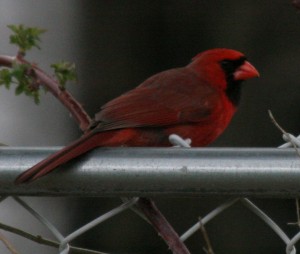 The female lays three to four eggs pale green eggs that are spotted red/brown in a cup shaped nest. Incubation takes 12 to 13 days. When hatched the chicks are naked except for sparse tufts of grayish down and eyes closed. Young fledge 10 to 11 days after hatching.
The female lays three to four eggs pale green eggs that are spotted red/brown in a cup shaped nest. Incubation takes 12 to 13 days. When hatched the chicks are naked except for sparse tufts of grayish down and eyes closed. Young fledge 10 to 11 days after hatching.
In the United States, the Northern Cardinal is the mascot of a number of athletic teams. In professional sports, it is the mascot of the St. Louis Cardinals of Major League Baseball and the Arizona Cardinals of the National Football League. In college athletics, it is the mascot of many schools, including the University of Louisville, the State University of New York at Plattsburgh, Ball State University, Illinois State University, Lamar University, the Catholic University of America, Wesleyan University, Wheeling Jesuit University, Massachusetts College of Pharmacy and Health Sciences, North Idaho College and Saint John Fisher College. It is also the state bird of seven states, more than any other species: North Carolina, West Virginia, Ohio, Illinois, Indiana, Kentucky, and Virginia.
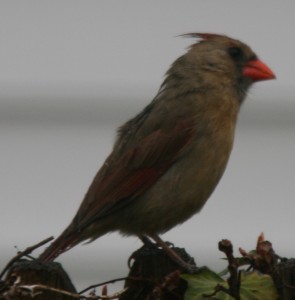 Identification: The Northern Cardinal is a mid-sized songbird that is 8” – 9“ long with a wing span of 10” – 12“. As can be seen from the pictures, the Northern Cardinal has a distinctive crest on the head and a mask on its face which is black in the male and gray in the female. The male is a brilliant crimson red with a black face mask over the eyes, extending to the upper chest. The color is dullest on the back and wings. The female is fawn, with mostly grayish-brown tones and a slight reddish tint on the wings, the crest, and the tail feathers.
Identification: The Northern Cardinal is a mid-sized songbird that is 8” – 9“ long with a wing span of 10” – 12“. As can be seen from the pictures, the Northern Cardinal has a distinctive crest on the head and a mask on its face which is black in the male and gray in the female. The male is a brilliant crimson red with a black face mask over the eyes, extending to the upper chest. The color is dullest on the back and wings. The female is fawn, with mostly grayish-brown tones and a slight reddish tint on the wings, the crest, and the tail feathers.
Young birds, both male and female, are similar to the adult female until the fall, when they molt and grow adult feathers.
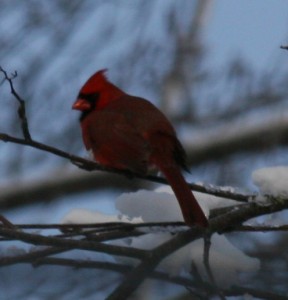 Habitat: The Northern Cardinal is found in woodlands, gardens, thickets, shrub-lands, and swamps. It is a common bird in suburbs and is a frequent visitor to backyard bird feeding stations.
Habitat: The Northern Cardinal is found in woodlands, gardens, thickets, shrub-lands, and swamps. It is a common bird in suburbs and is a frequent visitor to backyard bird feeding stations.
Territory: It can be found in southern Canada – Ontario, Quebec, and Nova Scotia and east, through the eastern United States from Maine to Texas and south through Mexico.
Migration: Cardinals are year round residents and really don’t have formal migratory patterns.
Food: Cardinals primarily eat seeds, grains, and fruits, however; they do eat insects to a lesser extent. Parent birds feed nestlings mostly insects.
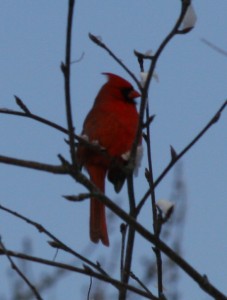
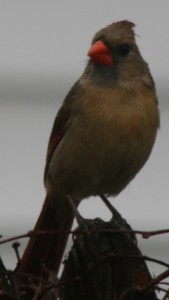
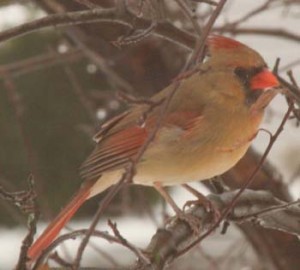
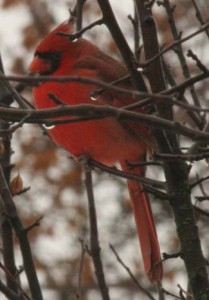
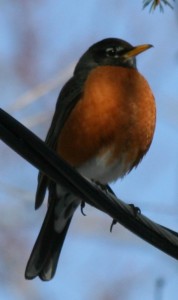 pesticide poisoning and can be an indicator of chemical pollution. Robins found in suburban and urban areas have lead levels in their blood that are roughly twice as high as robins from rural areas and the amount of lead in their blood suggest that some symptoms of lead poisoning are being manifested. Researchers have found that Robins appear to be a favored target of mosquitoes and many have Nile-Virus antibodies in their blood, this means that they were infected but have survived. (1)
pesticide poisoning and can be an indicator of chemical pollution. Robins found in suburban and urban areas have lead levels in their blood that are roughly twice as high as robins from rural areas and the amount of lead in their blood suggest that some symptoms of lead poisoning are being manifested. Researchers have found that Robins appear to be a favored target of mosquitoes and many have Nile-Virus antibodies in their blood, this means that they were infected but have survived. (1)